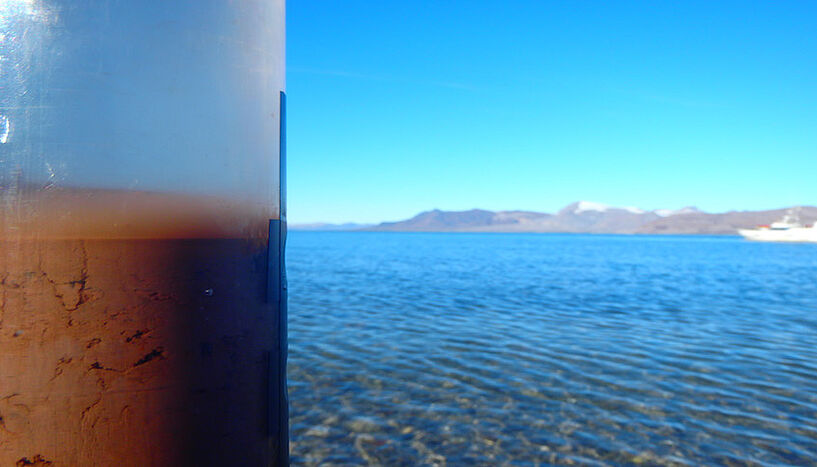Making a meal of DNA in the seafloor
14. Juni 2021
Marine Arctic sediment sample © Kenneth Wasmund
Specialised bacteria in the oceans seafloor consume and recycle nucleic acids from dead biomass
While best known as the code for genetic information, DNA is also a nutrient for specialised microbes. An international team of researchers led by Kenneth Wasmund and Alexander Loy from the University of Vienna has discovered several bacteria in sediment samples from the Atlantic Ocean that use DNA as a food source. One bacterium newly named by the team in fact is a true expert in degrading DNA. The study provides new insights into the diversity and ecological function of the still largely undescribed microscopic world in the oceans. It is now published in Nature Microbiology.
DNA is an abundant and nutritious food source for microbes
The diet of microbes is vast: They are able to use different molecules as nutrients, including biomolecules such as proteins and lipids of dead and decaying organisms. This includes so called extracellular DNA molecules which are not or no longer present in intact cells. "From the bacteria’s perspective DNA is particularly nutritious," says Kenneth Wasmund, a microbiologist at the Centre for Microbiology and Environmental Systems Science (CMESS) at the University of Vienna and lead author of the study. "It’s essentially a fertilizer. After all, it is a chain of millions of pieces of sugar and phosphorus- and nitrogen-containing bases." Extracellular DNA is common in the environment because when any organism dies, its contents, including DNA, are released into the environment. The microbes that degrade such abundant biomolecules are critical for global biogeochemical cycles as they recycle organic material settling from ocean waters, thereby also influencing how much carbon ultimately remains in the ocean floor. Yet, not all microbes are capable of using DNA as a nutrient.
Marine sediments are a massive habitat for undescribed microbes
The muddy sediments of the sea floor are a massive global habitat for these ecologically important microorganisms; after all, our oceans cover more than 70 percent of the earth's surface. Thousands of microbial species live here, most of which are still largely unknown. "Our study identifies some of these microbial players and reveals their lifestyles. At the same time, it tells us something about what happens to the vast amounts of DNA that are constantly released into the environment but do not accumulate anywhere and, accordingly, are obviously somehow being recycled," Kenneth Wasmund explains. Previous research has shown that microorganisms grown in the laboratory might use DNA as an energy source. "Our research has now focused on microbes that actually live and actively function in the seafloor, while using DNA as a food source," he adds.
Deciphering bacteria that use DNA for food by functional microbiome analyses
To this end, colleagues from the University of Calgary in Canada collected samples from the seafloor in the Baffin Bay, a marginal sea of the Atlantic Ocean between Greenland and Canada. To identify and characterise DNA-foraging microbes in these samples, the research team used an array of experimental, analytical, and bioinformatic methods. "In this collaboration of all four divisions at CMESS, we made full use of the excellent research infrastructure and unleashed the full expertise for functional microbiome analyses that is present at our Centre," says Alexander Loy, head of the research group at the University of Vienna.
In laboratory incubations, the researchers fed purified DNA that was isotopically-labelled with heavy carbon atoms (13C) to the sediment bacteria. Using stable isotope probing, including a specific isotope imaging technique, they were then able to track the heavy carbon and as a result could see which bacteria degraded the labelled DNA. In addition, the scientists reconstructed the genetic information present in the cells, i.e. the genomes, of the DNA-eating microorganisms to learn about their functional potential and distribution in the world’s oceans.
Novel DNA-eating bacteria in the seafloor
The metagenomic analysis showed that the bacteria were equipped with DNA-degrading enzymes that enable them to chop-up DNA into small pieces to help them take it up and consume it. One bacterial species stood out as it had a particularly sophisticated set of tools for degrading DNA. Their appetite for DNA, also called nucleic acid, is now borne in their name: The research team named them Izemoplasma acidinucleici.
Publication in Nature Microbiology:
Wasmund K, Pelikan C, Schintlmeister A, Wagner M, Watzka M, Richter A, Bhatnagar S, Noel A, Hubert C, Rattei T, Hoffman T, Herbold C, Hausmann B, Loy A. (2021). Genomic insights into diverse bacterial taxa that degrade extracellular DNA in marine sediments. Nature Microbiology. DOI: 10.1038/s41564-021-00917-9
Related publication on protein- and lipid-consuming bacteria:
Pelikan C, Wasmund K, Glombitza C, Hausmann B, Herbold C, Flieder M, Loy A. (2021). Anaerobic bacterial degradation of protein and lipid macromolecules in subarctic marine sediment. The ISME Journal. DOI: 10.1038/s41396-020-00817-6
Wissenschaftlicher Kontakt
Univ.-Prof. Dipl.-Biol. Dr. Alexander Loy
Zentrum für Mikrobiologie und Umweltsystemwissenschaft, Department für Mikrobiologie und Ökosystemforschung, Division für Mikrobielle ÖkologieUniversität Wien
1090 - Wien, Althanstraße 14
+43 1-4277-766 05
alexander.loy@univie.ac.at
Dr. Kenneth Wasmund
Zentrum für Mikrobiologie und Umweltsystemwissenschaft, Division für Mikrobielle ÖkologieUniversität Wien
1090 - Wien, Althanstraße 14
+43-1-4277-91236
kenneth.wasmund@univie.ac.at
Rückfragehinweis
Pia Gärtner, MA
Pressebüro der Universität WienUniversität Wien
1010 - Wien, Universitätsring 1
+43-1-4277-17541
pia.gaertner@univie.ac.at
Downloads:
WasmundLoy_Sedimentsample.JPG
Dateigröße: 89,25 KB
